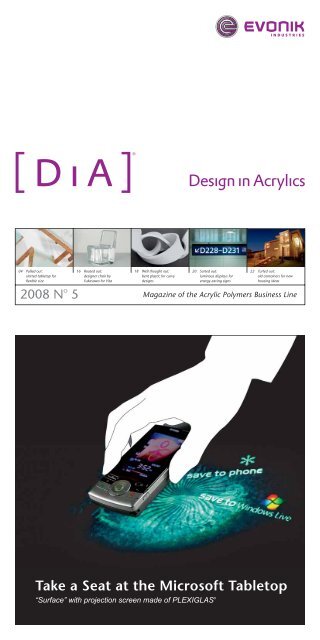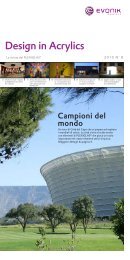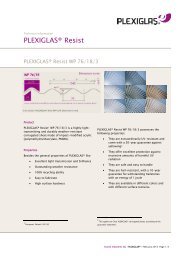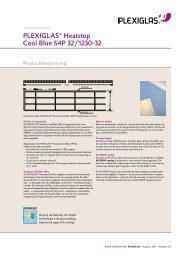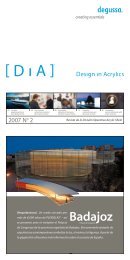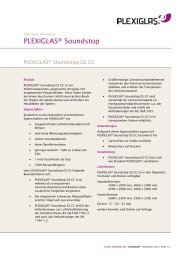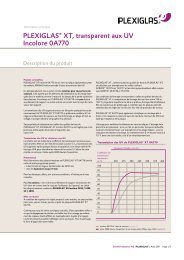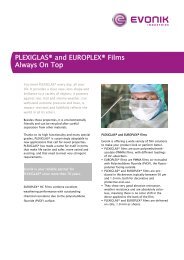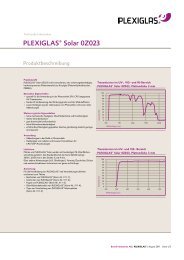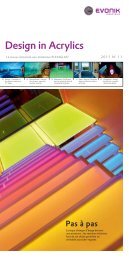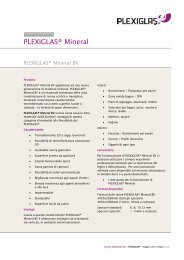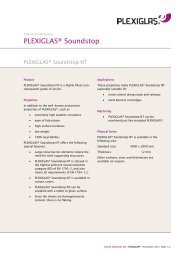PDF (1.68 MB) - PLEXIGLAS
PDF (1.68 MB) - PLEXIGLAS
PDF (1.68 MB) - PLEXIGLAS
Create successful ePaper yourself
Turn your PDF publications into a flip-book with our unique Google optimized e-Paper software.
®<br />
[ D l A ] Deslgn ln Acryllcs<br />
04 Pulled out:<br />
16 Routed out:<br />
18 Well thought out:<br />
20 Sorted out:<br />
22 Turfed out:<br />
slotted tabletop for<br />
designer chair by<br />
bent plastic for curvy<br />
luminous displays for<br />
old containers for new<br />
flexible size<br />
Fukasawa for Vita<br />
designs<br />
energy-saving signs<br />
housing ideas<br />
2008 N O 5 Magazine of the Acrylic Polymers Business Line<br />
Take a Seat at the Microsoft Tabletop<br />
“Surface” with projection screen made of <strong>PLEXIGLAS</strong> ®
2<br />
Dear Readers:<br />
To be fit for the future, we have to develop new perspectives based on experience and<br />
move with the times. <strong>PLEXIGLAS</strong> ® has done more than that for 75 years – this mutable<br />
material is usually one step ahead.<br />
The multimedia tabletop computer "Surface" has a huge touchscreen that is equipped<br />
with next-generation remote control software. It is set to become a multifunctional docking<br />
station for a variety of multimedia end devices. Thanks to its ultra-high purity <strong>PLEXIGLAS</strong> ®<br />
surface, infrared cameras can recognize cell phones, MP3 players and digital cameras placed<br />
on the surface. The stored information, whether music titles, photos or films, appears on the<br />
tabletop as an interactive stack. These data can be copied from one device to another just by<br />
pointing a finger.<br />
The new <strong>PLEXIGLAS</strong> ® signs at China's Pudong Airport in Shanghai also point people<br />
in the right direction. With low energy consumption, these signs guarantee uniform<br />
luminosity, offering dual benefits in terms of appearance and ecology.<br />
<strong>PLEXIGLAS</strong> ® is the foundation for many innovative developments by designers and<br />
artists. American architect Peter DeMaria shows how recycling is meant to work. He combined<br />
<strong>PLEXIGLAS</strong> ® elements and redundant shipping containers to produce an ultramodern<br />
detached house.<br />
And Japanese designer Naoto Fukasawa makes his own contribution to furnishings.<br />
He has designed a series of unadorned, functional chairs. One of them is made from three<br />
almost invisibly bonded blocks of transparent <strong>PLEXIGLAS</strong> ® .<br />
We hope you draw inspiration from these and other topics.<br />
Wishing you an enjoyable read,<br />
Michael Träxler,<br />
Senior Vice President<br />
Acrylic Polymers BL<br />
A Moment in Time<br />
A new star lights up the night sky of Moscow: advertising companies<br />
in the Russian capital have now discovered illuminated signs made from<br />
<strong>PLEXIGLAS</strong> ® EndLighten. The signs can be seen all over the city and<br />
make sure the message hits home, especially in the dark. <strong>PLEXIGLAS</strong> ®<br />
EndLighten is a light-diffusing transparent acrylic with special lightguiding<br />
behavior.<br />
Illuminated displays equipped with edge-lit sheets of <strong>PLEXIGLAS</strong> ®<br />
EndLighten distribute the light fed in via the edges uniformly across the<br />
entire surface. The material makes it possible to produce ultra-slim, largesized<br />
displays that are uniformly lit on one or both sides.<br />
[Dl A] ®
3<br />
A form of expression for new ideas for 75 years. From bus glazing to the so-called Snow White‘s Coffin (middle of first row) and Badajoz Congress Center (middle of third<br />
row): the acrylic from Evonik Röhm GmbH offers convincing performance in all its applications.<br />
75 Years of Innovation<br />
Ideas and visions are the driving forces behind science and research. Otto Röhm, the inventor of<br />
acrylic, also followed his vision.<br />
[History] Seventy-five years after the discovery of<br />
acrylic, the success story of this material is far from over. On the<br />
contrary, it has just started. New material properties have been<br />
found using innovative discoveries like<br />
nanotechnology. One result is that the<br />
impact strength of this plastic has been<br />
further enhanced by incorporating nanoparticles,<br />
compounds of a few or several<br />
thousand atoms or molecules.<br />
This story had already begun in<br />
1901, when Swedish King Gustav VI<br />
Adolf conferred the Nobel Prize for the<br />
first time. This was precisely when German<br />
scientist Otto Röhm wrote his doctoral<br />
thesis on acrylic acid, a clear chemical<br />
compound miscible with water, with<br />
a pungent acidic odor. Back then, he already had the idea of putting<br />
the chemical to a variety of uses, and devoted all his research<br />
to the acrylates family, with astounding results only a few<br />
years later.<br />
When it all began<br />
In the “golden twenties,” the cultural and economic heyday<br />
in the first half of the twentieth century, an important discovery<br />
was made almost by chance. The idea was to form a sheet<br />
from residues of the polymerization process. To do so, the residues<br />
were compressed between two panes of glass exposed to<br />
heat. The result was an unexpectedly firm bond between the<br />
two panes of glass, which marked the discovery of the laminated<br />
safety glass called LUGLAS ® . In the same way, experiments were<br />
conducted with methyl methacrylate. This time, the compound<br />
was easy to remove from the glass sheets. The result was an extremely<br />
stable and highly transparent plastic, acrylic, which was<br />
launched on the market in 1933.<br />
as aircraft glazing. In the 1940s and 1950s, interior designers<br />
discovered the material for their creations. But the material had<br />
more to offer than mere transparency. The development of continuously<br />
new colors, surface textures,<br />
geometries and sophisticated properties<br />
made acrylic more versatile than ever before.<br />
Intensive research and development<br />
meant that the product range was constantly<br />
extended. Noise barriers along<br />
highways, wind protection on bridges,<br />
antistatic picture glazing and colorful illuminated<br />
signs are only a few examples.<br />
The future starts here<br />
Despite all the confidence Otto<br />
Röhm had in his product, the range of applications is now vaster<br />
than he could ever have imagined 75 years ago. Nor could he<br />
have dreamed that acrylic would ever be suitable for producing<br />
small, lightweight portable telephones that need no base station<br />
and no cables. Yet transparency, clarity, scratch resistance and<br />
good light-guiding properties are precisely the special features<br />
that make this material so appropriate for cell phone screens<br />
and light guides for TFT displays. Acrylic already contributes to<br />
protecting our climate and the environment. In photovoltaics,<br />
a technology that generates power from light, the material ensures<br />
that a maximum of light is guided to the solar cell to enable<br />
optimum use of power. Without a doubt, Otto Röhm let<br />
himself be guided by an idea that remains full of innovative potential<br />
even 75 years on. dr<br />
www.plexiglas.net<br />
Gold for Röhm<br />
The versatility of this discovery became apparent in 1935.<br />
Röhm had the unusual idea of making musical instruments<br />
from the material, and a violin was finally produced after lengthy<br />
studies. In 1937, Röhm received the Grand Prix for this innovative<br />
product at the World‘s Fair in Paris. At this point in time, the<br />
plastic was already being put to a number of different uses, such<br />
[Dl A] ®
4<br />
Mutable is the motto of a<br />
furniture series from Lignum<br />
Arts.<br />
Cube-shaped shelves hide<br />
away chairs that can be<br />
taken out as required.<br />
Take a seat on<br />
<strong>PLEXIGLAS</strong> ® and<br />
bamboo.<br />
[Dl A] ®
5<br />
Laser-cut <strong>PLEXIGLAS</strong> ® can be pushed together or pulled apart like an accordion, depending on the desired size of the table.<br />
Shape-Shifters<br />
Pull-out tables, concealable chairs:<br />
Unusual furniture from Lignum Arts<br />
[Furniture Design] A furniture series with a small<br />
table that can be simply extended, and four chairs that disappear<br />
inside shelves when not in use – these were what Tobias<br />
Jung had in his mind's eye, at least, when he sat his master<br />
craftsman exams at the school of carpentry in Garmisch, Upper<br />
Bavaria, in 2000. Now he has made his idea come true. Jung runs<br />
the furniture company Lignum Arts near Munich together with<br />
his associate Dennis Dostmann. This is where the master carpenter<br />
realizes his ideas for innovative furniture and interior<br />
design concepts, which are all flexible, functional and unusuallooking.<br />
Versatile materials like <strong>PLEXIGLAS</strong> ® are essential in his<br />
line of business: “It's a smart material because it has a finished<br />
surface that needs no further treatment. That means less work.<br />
And it can be flexibly curved and formed to the required shape,”<br />
Jung says.<br />
The accordion as role model<br />
One of his most unusual designs is an extendable table<br />
made of bamboo and <strong>PLEXIGLAS</strong> SATINICE ® . “Our basic idea<br />
was to develop a table that can be pulled out simply and<br />
smoothly. For this we needed a material that could be laser-cut,<br />
and that's how we came across <strong>PLEXIGLAS</strong> ® ,” Jung reports. The<br />
table is based on the principle of the accordion. For this, the<br />
<strong>PLEXIGLAS</strong> ® sheet is slit with a laser like expanded metal. The<br />
material is very elastic and can therefore be pulled apart very<br />
easily. Since the <strong>PLEXIGLAS</strong> ® structure is not subsequently<br />
covered by a separate table leaf, the lasered slits cannot be more<br />
than one centimeter apart – otherwise glasses would wobble and<br />
small objects could fall through the openings. It comes as no<br />
surprise that Jung chose <strong>PLEXIGLAS</strong> SATINICE ® for this table, it<br />
being his favorite material: “The new shades of gold, grey and<br />
brown are absolutely fantastic,” says Jung, who has already received<br />
the coveted red dot design award for one of his previous<br />
ideas. Jung keeps up to date on the fur ther development of<br />
<strong>PLEXIGLAS</strong> ® shapes, colors and material textures, and cooperates<br />
closely with König Kunststoffe, who give him material<br />
samples, product information and fabrication tips. He sees a<br />
future for his <strong>PLEXIGLAS</strong> ® and bamboo furniture especially at<br />
trade shows and as store fixtures. But this chic and functio nal<br />
furniture is popular for office furnishing, too.<br />
Adaptable appointments<br />
Jung developed a matching chair with a similar appearance<br />
and an added extra. The <strong>PLEXIGLAS</strong> ® backrest can be removed,<br />
inserted in the frame and put away in a matching set of shelves.<br />
Since all elements of the furniture collection are so mobile and<br />
variable, Jung has named the series “Mutable.” Conspicuous is the<br />
combination of bamboo and <strong>PLEXIGLAS</strong> SATINICE ® in Silicate<br />
Green, which looks futuristic yet natural, because of the wood.<br />
Here, the synthetic and natural material unite to form a harmonious<br />
whole. dr<br />
www.lignum-arts.de<br />
A table that grows for<br />
large and small<br />
meetings<br />
[Dl A]<br />
®
6<br />
Safe Escort<br />
Illuminated handrail for stairs<br />
[Lighting] As night falls in South Africa, the sky over a<br />
holiday home in Cape Town slowly darkens. In the stairwell,<br />
shadows creep across a sculpture and an oil painting. Just then,<br />
the staircase banister starts to glow and lights the way.<br />
The owners of the holiday home wanted an unusual type<br />
of lighting, reports Ulrich Lorenzen, chief design engineer at<br />
LED specialist Lumière Technologies. So the department for industrial<br />
design headed by Berno Wellmann developed a handrail<br />
lit by LEDs, and chose a tube of <strong>PLEXIGLAS</strong> SATINICE ® as the<br />
suitable material. “It was the best option to use: From a lighting<br />
diffusing perspective it did exactly what we required as we<br />
compared the result to a clear glass tube that was sandblasted.<br />
The diffusion was more even due to the inherent texture of<br />
<strong>PLEXIGLAS</strong> SATINICE ® that was part of the acrylic manufacturing<br />
process.” The uniform glow also convinced the customer. An<br />
added bonus is that the handrail is easy to clean because the<br />
smooth <strong>PLEXIGLAS</strong> ® surface discourages dirt and handprints.<br />
The banister‘s elegant appearance conceals a sophisticated<br />
structure. Three hundred LEDs are mounted on an aluminum<br />
rail inside the 4.3-meter-long tube. The inner texture of the rail<br />
cools the light sources and simultaneously connects the tube<br />
with the four steel wall brackets. Whereas the main electric cable<br />
runs inside the wall, the LEDs are linked to it via the inside of the<br />
made-to-measure wall brackets. Since the system runs on low<br />
voltage (10 V), it is very safe and has a maximum energy consumption<br />
of 60 watts. In principle, it could also be used as<br />
emergency lighting for escape routes. “That will become a more<br />
attractive option as LED technology becomes even cheaper in<br />
the future,” Lorenzen says. The construction principle also<br />
lends itself to other applications. Lorenzen and his colleagues<br />
are currently working on an eight-meter-high water level indicator<br />
for an exclusive yacht harbor. Rather than helping people<br />
safely up stairs, here the system makes sure ships pass through a<br />
lock without mishaps. hf<br />
www.lumiere.co.za<br />
Made-to-measure wall<br />
bracket that also supplies the<br />
illuminated handrail with<br />
electricity<br />
New additions to the range of extruded <strong>PLEXIGLAS</strong> ®<br />
tubes and rods<br />
80<br />
O<br />
5<br />
O 20<br />
97<br />
67<br />
120°<br />
O 50<br />
O 50<br />
45<br />
Tubes<br />
Previously, extruded <strong>PLEXIGLAS</strong> ® tubes<br />
were only available with an outside diameter<br />
of 5 to 300 mm.<br />
Since February 2008, the tubes have<br />
been available with<br />
– outside diameters of 400 mm, 450<br />
mm and 500 mm<br />
– wall thicknesses of 4 mm and 5 mm<br />
– a standard length of 2000 mm.<br />
Special lengths are possible on request.<br />
Applications:<br />
– transparent seamless displays for furniture,<br />
tradeshow booths and store fixtures<br />
– XXL lamps and lighting fixtures<br />
Round rods<br />
<strong>PLEXIGLAS</strong> ® rods have been frequently<br />
used for staircase banisters and handrails,<br />
lamps, lettering, spectacle stands,<br />
displays and furniture. New to the<br />
range are <strong>PLEXIGLAS</strong> ® EndLighten<br />
round rods. One light source at the end<br />
of the rod suffices to uniformly illuminate<br />
the entire rod. That saves energy<br />
and prevents hot spots. <strong>PLEXIGLAS</strong> ®<br />
EndLighten round rods have the additional<br />
advantage of being much more<br />
impact-resistant than glass.<br />
Applications:<br />
– lettering<br />
– lamps<br />
– furniture lighting<br />
– indirect light<br />
[Dl A] ®
®<br />
7<br />
Adhesive Goes AWOL<br />
ACRIFIX ® at the service of designers<br />
[Technology] “Soyons Fou!” (Let's Go Crazy) is the<br />
name of a French communications design agency, a name that<br />
says it all. Designers there have been working with illuminated<br />
furniture for almost 15 years. When it came to designing two<br />
<strong>PLEXIGLAS</strong> ® bars for the French vodka label “Grey Goose,” Grégoire<br />
Thibault and his colleagues at Soyons Fou! wanted the<br />
special bar design and blue-white light to remind viewers of icecold<br />
vodka. The challenge was to incorporate transparent elements<br />
into the matte surface of <strong>PLEXIGLAS</strong> SATINICE ® and illuminate<br />
them to provide sophisticated lighting effects.<br />
Soyons Fou! found the unusual solution to their idea in the<br />
“Creative Box” of the <strong>PLEXIGLAS</strong> ® It’s Magic<br />
campaign conducted by Evonik Röhm GmbH. As<br />
well as a number of material samples from the<br />
entire product range, the box contains a selection<br />
of different ACRIFIX ® adhesives for bonding<br />
<strong>PLEXIGLAS</strong> ® , to which ACRIFIX ® is chemically<br />
closely related. When applied to a surface, it initially<br />
causes the material to swell at the site of<br />
application. As the surfaces cure, they are united<br />
when the acrylic molecules become interlocked.<br />
The French designers took advantage of this property. They<br />
applied the adhesive to both sides of the bar material using stencils<br />
to create the logo. This provided a translucent effect at the<br />
places where the adhesive had dissolved the matte surface.<br />
Grégoire Thibault says: “We illuminate the bonded shapes with<br />
white light and blue spotlights. The adhesive left fine lines<br />
and bubbles on the material that underline the freshness and<br />
liveliness of the design. The effect is truly astonishing.” Helmut<br />
Hilsmann, Acrylic Sheet Sales Manager France adds: “It's far from<br />
easy to create clean lines using an adhesive and stencils. The<br />
adhesive tends to seep below the stencil. But Soyons Fou!<br />
ACRIFIX ® adhesive lends special transparency to the shape of<br />
the "Grey Goose“ vodka emblem.<br />
brought it off. The transparent bonded surface makes for a<br />
brilliant appearance.”<br />
Evonik is presently working on a brochure that gives an<br />
overview of the extensive range of <strong>PLEXIGLAS</strong> ® adhesives. The<br />
new feature is that the brochure sums up the entire adhesives<br />
range. “The technical data sheets we have produced so far, and<br />
will continue to use, only provide information on individual<br />
adhesives," Martin Hoffmann, Product Manager Performance<br />
Polymers, tells us. “The new brochure contains a two-page<br />
decision tree that helps users select the suitable product.” The<br />
new brochure is set to appear this summer. em<br />
www.soyonsfou.com<br />
One More Shot for <strong>PLEXIGLAS</strong> ®<br />
Filming a climate protection video<br />
[Vodcast] “Yes, that was very good – one more time!“<br />
And another, and another. Cameramen are never satisfied, and<br />
patience is of the essence. But in the end, it is obvious why the<br />
man behind the camera was so obstinate. Video shots have to be<br />
perfect, otherwise they detract from the content. And with the<br />
vodcasts filmed for the <strong>PLEXIGLAS</strong> ® campaign “This is what climate<br />
protection looks like,” the content is all-important. The lat -<br />
est video deals with lighting and how <strong>PLEXIGLAS</strong> ® saves energy.<br />
It can be viewed at the website: www.plexiglas-and-energy.com<br />
www.plexiglas-and-energy.com<br />
[Dl A]
8<br />
“The pathbreaking development here was that we equipped an entire studio<br />
almost entirely with <strong>PLEXIGLAS</strong> ® ,”<br />
says Martin Scherffig, head of the equipment department at Hessischer Rundfunk<br />
Exciting Viewing<br />
Leading role for <strong>PLEXIGLAS</strong> ®<br />
[TV Studios] It only takes a few seconds to switch from<br />
channel to channel on the remote control, and straight away we<br />
can see which series, news program or show we've found. Apart<br />
from the TV presenters themselves, it's the stage set that gives<br />
each format its typical and individual face. Sets have to be creative,<br />
eye-catching and unique. And often it is <strong>PLEXIGLAS</strong> ® that<br />
adds the finishing touch to many TV studios.<br />
New “outfit“ in Norway<br />
In all, Norwegian TV recently equipped 16 new studios<br />
with <strong>PLEXIGLAS</strong> ® . Three news broadcast studios in Oslo and<br />
thirteen more local studios were given a face-lift. “The materials<br />
were routed, thermoformed and individually cut to size for each<br />
set. Some of the surfaces of the presenters' desks were paneled<br />
with <strong>PLEXIGLAS</strong> SATINICE ® by means of a special technique,”<br />
says Petra Carnbäck at Glasfiber & Plastprodukter AB, the company<br />
that supplied the material for the huge project. The new<br />
rooms were given an ultra-modern look with futuristic backdrops,<br />
a variety of colors and different shapes.<br />
Pathbreaking developments with <strong>PLEXIGLAS</strong> ®<br />
German regional broadcasting company Hessischer Rundfunk<br />
(HR) in Frankfurt has already had experience with the material,<br />
which is used to advantage in HR's TV studios. The studio<br />
used for the De Facto program plays a special role: “The pathbreaking<br />
development here was that we equipped an entire studio<br />
almost entirely with <strong>PLEXIGLAS</strong> ® ,” says Martin Scherffig,<br />
head of the equipment department at HR. Although there are<br />
plenty of programs that manage without real studio sets and<br />
make do with digital spaces, landscapes or backgrounds using<br />
blue screen technology, they will not replace real studios: “This<br />
technology can't replace the furniture used by guests and pre -<br />
senters, nor the big sets for entertainment shows with a live<br />
audience,” Scherffig says. At the moment, satin materials are<br />
[Dl A] ®
9<br />
“Whether for magazine programs, news broadcasts or shows,<br />
the material will continue to play a leading role on TV and stay<br />
on the scene for a long time to come.”<br />
very popular since their light transmission combined with<br />
studio lighting offers many advantages and shows the studio<br />
lighting in its true colors on the viewer's screen at home. The<br />
material is machined, cut to size and repaired at HR's own workshop.<br />
But it is not just the material's variety of colors, formability<br />
and manifold properties that make this plastic a firm component<br />
of studio and stage sets; its impact strength, ease of machining<br />
and special advantages in terms of fire protection are<br />
further benefits : “In the event of fire, <strong>PLEXIGLAS</strong> ® produces<br />
neither thick smoke nor toxic fumes, and is easy to extinguish.<br />
This has been confirmed by many independent institutes and<br />
fire experts,” says Martin Berkenkopf, Product Manager at Acrylic<br />
Polymers BL.<br />
Scherffig also intends to keep using <strong>PLEXIGLAS</strong> ® : “Whether<br />
for magazine programs, news broadcasts or shows, the material<br />
will continue to play a leading role on TV and stay on the scene<br />
for a long time to come.” dr<br />
International TV presence: studio designers in Norway too rely on <strong>PLEXIGLAS</strong> ® .<br />
www.plexiglas.net<br />
[Dl A]<br />
®
10<br />
Mysterious Shape-Changer<br />
Aiorema grows seamlessly out of the asphalt like a glowing stalagmite.<br />
The structural marquee bears the inscription “Portland Center Stage.”<br />
[Interior Design] The sculpture created by artist<br />
James Harrison was to have a “ghostly, ephemeral” aura, he says.<br />
And at first sight, it certainly gives no hint of the sophisticated<br />
technology concealed inside, like the fiber optic ropes fed by a<br />
150-watt light source that illuminate the sculpture. Nor does<br />
one see the three solid steel rods that keep Aiorema in shape. All<br />
in all, the structure makes quite a few passersby stop in their<br />
tracks.<br />
Show the best, hide the rest<br />
The easiest way to hide the technical equipment would<br />
have been to install a platform beneath the sculpture. “Unfortunately<br />
that would have given it a completely mundane appearance,”<br />
Harrison says. So he came up with a different idea. The<br />
sculpture is shaped like a cloud at the base and like a star against<br />
the sky. The shapes that symbolize the Greek seat of the gods<br />
thus morph into each other. It took a total of 215 individual<br />
sections that the artist cut from 27 <strong>PLEXIGLAS</strong> ® Satin Ice sheets<br />
using a water jet cutter. The individual parts were then posttensioned<br />
on site on three steel rods inserted in the asphalt.<br />
To conceal the technical equipment, Harrison created a<br />
cavity in the middle of the structure, which was later to accommodate<br />
the fiber optic ropes. The sole access is provided by a<br />
door at the base of the sculpture. For this, Harrison cut segments<br />
about 30 cm wide out of some of the large sheets at the base of<br />
Aiorema and bonded them separately. The door itself also had to<br />
be segmented so as not to detract from the overall impression.<br />
The artist screw-fastened the segments with special screws that<br />
can only be undone with a special screwdriver. He did this to<br />
prevent anyone who happens to have an ordinary screwdriver<br />
on them from snuffing out Aiorema's light.<br />
meanings: a contrivance used in ancient Greek theater to resolve<br />
a seemingly intractable problem in the plot, and the name<br />
of the device that brought off this theatrical trick - a crane that<br />
was used to lower an actor playing a god onto the stage while he<br />
announced his improbable solution.<br />
“I thought Aiorema was an appropriate way to link old and<br />
new. New theater, old concept - old building, new marquee,”<br />
Harrison explains.<br />
Aiorema's secret<br />
It is not by chance that the sculpture was made from<br />
<strong>PLEXIGLAS</strong> ® . “This material met all the requirements,” the designer<br />
sums up. “It is hard enough to provide stable structures<br />
and affordable, unlike some other synthetic materials.“ Added<br />
to this, it is highly weather-resistant and has the required light<br />
transmission properties. <strong>PLEXIGLAS</strong> ® Satin Ice is translucent but<br />
not transparent, and has a special diffuser structure that offers<br />
exceptional lighting properties. It distributes the light evenly<br />
across the entire surface without revealing any of its innermost<br />
secrets.<br />
Aiorema remains a mystery to the eye. smw<br />
www.plexiglas.net<br />
Eye-catcher with a history<br />
The American designer created the sculpture made of<br />
<strong>PLEXIGLAS</strong> ® Satin Ice for the famous Portland Center Stage<br />
(PCS) in the state of Oregon. Shortly before, the theater had<br />
moved to the city's renovated historic Armory building. To draw<br />
people's attention to the new location, PCS needed a real eyecatcher.<br />
Aiorema is the Greek word for what is known in Latin as<br />
deus ex machina, a god from a machine. The term has two<br />
Aiorema consists of 215<br />
individual parts assembled by<br />
hand.<br />
[Dl A] ®
11<br />
Dining in Different Dimensions<br />
A room within a room made of PLEXICOR ®<br />
[Interior Design] Replacing an office block with a<br />
canteen for guests is a task that, while creative, calls for a utilitarian<br />
approach. “Our guest canteen had to be designed based on a<br />
standard floor plan that was mainly designed for offices,” says<br />
Steffen Bader, Project Manager at SAP in Walldorf. The interior<br />
designers at Häussler GmbH Office Solutions accepted this challenge<br />
and presented an attractive concept. They divided the<br />
canteen and lounge into different areas using wooden and carpeted<br />
flooring, ceiling-high facade glazing, a projecting ceiling<br />
and a very special cube in the center of the room, which is a sheltered<br />
area offering privacy and constitutes the centerpiece of the<br />
lounge.<br />
Intensive search for material<br />
The room inside a room is open on two sides. The floor,<br />
ceiling and walls form one broad strip that is rolled up like a<br />
tube. The floor of the cube is paneled with PLEXICOR ® , which<br />
the interior designers came across after an intensive search. “We<br />
hadn't worked with it before, but we were looking for something<br />
that met our technical, aesthetic and design requirements at the<br />
same time.” The material was not only meant to underline the<br />
canteen's innovative atmosphere, but also be strong enough to<br />
take the daily wear and tear on these busy premises. The flooring<br />
had to be non-skid and resistant to abrasion and chemical cleaning<br />
agents.<br />
PLEXICOR ® won the contest<br />
The options discussed included rubber, PVC and laminated<br />
flooring. “But those would not have offered the brilliance<br />
and color we were looking for,” the team explains. Another alternative<br />
would have been mineralized plastics. “But because<br />
these plastics are textured, you can always see the joints between<br />
the sheets.” That would have been contrary to the design.<br />
“We wanted an uninterrupted surface.” The flooring was to<br />
segue seamlessly into the curved walls. “PLEXICOR ® now acts as<br />
a continuous surface without joints, just like we wanted.” smw<br />
www.plexiglas.net<br />
The room open on both sides appears to hover inside SAP‘s guest canteen.<br />
[Dl A] ®
13<br />
Take a Seat at the<br />
Microsoft Tabletop<br />
Microsoft Surface has a projection screen made of <strong>PLEXIGLAS</strong> ®<br />
[Multimedia] When you put a digital camera on the<br />
tabletop, photos appear on its surface. These can be pushed<br />
around, turned, enlarged or made smaller at the touch of a fingertip.<br />
No need for a mouse, keyboard or cables. That will be one<br />
of many future applications.<br />
Anyone who can spread out holiday snapshots, pile up<br />
magazines or place their cell phone on their coffee table can also<br />
operate Surface. The unassuming name stands for a multimedia<br />
tabletop computer jam-packed with complex technology.<br />
Surface looks just like a coffee table. And it may well<br />
feature in living rooms quite soon, as a multifunctional touchscreen<br />
for operating television, stereo equipment and heating<br />
systems. Or it might stand in the kitchen, where it will serve<br />
as a source for recipes, for managing food stocks and as a<br />
monitor for ordering the next lot of shopping. At the moment,<br />
this is all visionary stuff, but the communications medium<br />
can already be found in several casinos, stores and selected<br />
restaurants in the USA. Soon it may replace the menu, the<br />
board game and the dining table. Guests could leaf through<br />
virtual pages, select items with their fingertips and order by<br />
lightly pressing the desired item. Then the interface could turn<br />
into a board game. The waiter would only need to come to the<br />
table when the order was ready. At the end of the meal, guests<br />
could also pay via Surface, comfortably, with no need for cash<br />
and no waiting.<br />
Dinner is served<br />
For all this to work, it takes an ordinary computer with<br />
Microsoft Vista and highly sophisticated software. Several users<br />
can simultaneously select items at one Surface tabletop, and<br />
their inputs are registered and interpreted via an infrared lens.<br />
Five cameras measure the infrared signals coming from the interface.<br />
To avoid misunderstandings, the screen has to meet the<br />
most stringent optical requirements. It is composed of several<br />
functional optical layers based on <strong>PLEXIGLAS</strong> ® .
14<br />
Up for grabs<br />
An interdisciplinary team of plastics specialists,<br />
physicists, chemists and materials analysts worked together<br />
to devise the precise formulation of the individual<br />
layers, their combination and joint effects, in<br />
a development cooperation arrangement between<br />
Microsoft and Evonik. At the end of this period, the<br />
tabletop was ready to face the digital future.<br />
"We redefined quality by working on Surface.<br />
We're talking about optical technologies fit for the<br />
next millennium, which can't be compared with<br />
anything we've done so far," says Dr. Alexander Laschitsch.<br />
Together with Frank Lerch, he is responsible<br />
for the project at Evonik Röhm GmbH.<br />
"Our company has had rear projection expertise<br />
for some time, and that helped us to handle this huge challenge,<br />
where all the components have to be adjusted to each other<br />
down to the last detail to provide the optimum result," Lerch<br />
adds.<br />
With a product like Surface, the feel is important. People<br />
have to feel that the screen is pleasant to touch, because it's the<br />
only way they communicate with the computer. "We produced<br />
ten models with different surface properties. A design team at<br />
Microsoft opted for the present material. Various factors play a<br />
role when judging the feel of the material, but the important<br />
criteria were surface toughness and hardness," Lerch explains.<br />
The surface material will be produced in Weiterstadt near<br />
Darmstadt, Germany, under clean-room conditions. Surface is<br />
to make its way into private households within about five years.<br />
Then everyone, with computer experience or not, can dip into<br />
the digital world and discover new realms of modern communication.<br />
ck
Dr. Alexander Laschitsch, Evonik Röhm GmbH<br />
15<br />
<strong>PLEXIGLAS</strong> ® the basis for this product,<br />
is the material best suited for meeting the<br />
stringent requirements of the projection<br />
screen, thanks to its excellent optical and<br />
physical properties. Together, these provide<br />
a stable, hard-wearing yet highly sensitive<br />
tabletop for the Surface TM . One crucial detail<br />
at the heart of Surface TM is a rear projection<br />
film specially developed for this application.<br />
It provides a clear picture and ensures the<br />
information is transmitted without errors.<br />
“We redefined quality by<br />
working on Surface. We are talking<br />
about optical technologies<br />
fit for the next millennium,<br />
which can‘t be compared with<br />
anything we‘ve done so far.“
®<br />
16<br />
Affordance for Sitting<br />
Naoto Fukasawa<br />
creates <strong>PLEXIGLAS</strong> ® chair for Vitra<br />
[Furniture Design] The <strong>PLEXIGLAS</strong> ® “Chair” by<br />
Japanese product designer Naoto Fukasawa looks as if it were<br />
hewn from a huge chunk of ice, transparent and clear. He himself<br />
describes it as a “chair-like thing to sit on.” The object appears<br />
to be melting like ice in the sun and dissolving into its environment,<br />
caught in the act of disappearing.<br />
When designing his objects, the designer respects people‘s<br />
natural inclination to take what they see around them as an unconscious<br />
invitation to act. This approach rests on the work by<br />
perception psychologist James Jerome Gibson, who lived in the<br />
USA from 1904 to 1979. Gibson coined the term “affordance” to<br />
describe this characteristic of objects that offer the possibility<br />
for action – the usability the environment offers people in a<br />
given situation.<br />
In 2007, Fukasawa designed the “Chair“ series for Vitra<br />
Edition. Vitra is a design-oriented production company headquartered<br />
in Birsfelden, Switzerland, which has developed a<br />
wide range of furniture for offices, homes and public buildings<br />
since 1957. But Vitra also stands for something more: a design<br />
museum, a furniture collection, workshops and publications.<br />
Naoto Fukasawa‘s <strong>PLEXIGLAS</strong> ® “Chair” is one of nine that<br />
the designer created from different materials for Vitra Edition.<br />
The chairs are meant to invite people to take a seat by responding<br />
to natural human behavior. “They are so normal that we say<br />
to ourselves ‘I‘d like to sit down here.‘ The only thing that can<br />
interfere with such behavior are conscious intentions. But our<br />
best choices are made without thinking,” the designer says.<br />
Routed from a single block<br />
To manufacture the <strong>PLEXIGLAS</strong> ® chair, Vitra turned to<br />
HEINZ FRITZ Plastics Processing in Herbrechtingen, a company<br />
that has been working with Evonik Röhm for over 50 years and<br />
has experience with machining thick blocks. “We often work<br />
with up to 200-mm thick <strong>PLEXIGLAS</strong> ® blocks to make glazing<br />
for large aquariums, for example,” says Heinz Fritz. “But we<br />
needed much thicker blocks for the <strong>PLEXIGLAS</strong> ® ‘Chair’.” So<br />
Evonik simply laminated three 160mm blocks together. This<br />
technique has the advantage over bonding that the joint is<br />
barely visible. The result was a block measuring 2000 by 1200 by<br />
515 millimeters, with a thickness of 515 millimeters. Fritz<br />
routed the chair out of the block, sanded and polished it. “Routing<br />
of a solid object calls for a lot of know-how and places enormous<br />
demands on machine performance,” says Heinz Fritz. “We<br />
have several CNC routers, the biggest being a 20-meter-long<br />
five-axle CNC router. With that, you could even cut a sailing<br />
boat out of one piece of material. Manual sanding of the routed<br />
block using successively fine abrasive paper and the final<br />
polishing of this jewel calls for extreme sensitivity to the designed<br />
shape and the ultimate in craftsmanship.”<br />
Wolfgang Stuber, Product Manager Acrylic Polymers BL,<br />
adds: “Blocks are the ideal material for objects like the Fukasawa<br />
“Chair”. The challenge for us was the required thickness.” There<br />
“People sat down long before chairs<br />
existed, on rocks or fallen trees. Given<br />
certain circumstances, everyone looks<br />
for a natural object or material to sit<br />
on. The choice is not necessarily a<br />
chair.“<br />
Naoto Fukasawa<br />
is a limit to the thickness in which polymethyl methacrylate<br />
(PMMA) can be produced because at some point, the material<br />
no longer cures properly. That was why three blocks were laminated<br />
together. As Stuber says: “That can only be done with<br />
<strong>PLEXIGLAS</strong> ® and would be impossible with glass. Fritz supplied<br />
the missing link in this project by subsequently fabricating<br />
the raw material. They have many years of experience with<br />
handling blocks, whether for illuminated furniture or aquariums,<br />
and are the ideal partners for producing this exceptional<br />
work of art.” em<br />
Please take a seat! The<br />
transparent chair was<br />
routed out of a single<br />
block of <strong>PLEXIGLAS</strong> ® .<br />
[Dl A]
17<br />
Green sheets of <strong>PLEXIGLAS</strong> ® turn the sand of the riding arena at Darmstadt Technical University into a meadow.<br />
Grazing Under a Leafy Canopy<br />
Architecture with attitude for a historical riding arena<br />
[Architecture] The structure made of <strong>PLEXIGLAS</strong> ® ,<br />
wood and metal looks like a leafy canopy. The round metal<br />
“trunks” are inserted in the ground at an angle and are irregularly<br />
distributed. They hold up an undulating roof with triangular<br />
transparent green <strong>PLEXIGLAS</strong> ® sheets. The architects at the 54F<br />
agency in Darmstadt call the roof over the riding arena at Darmstadt<br />
Technical University (TUD) the “equestrian canopy”.<br />
“We had to come up with a very special design, otherwise the<br />
office for the preservation of historical monuments wouldn't<br />
have given its approval,” says 54F architect Claus Staniek. The<br />
riding arena is located on a manorial estate that was built as a hotel<br />
in 1907. Back then, guests arrived by horse-drawn carriage, and<br />
required stabling. Today, the historical compound comprising<br />
the riding stables and guesthouse belongs to the university and<br />
is a listed building.<br />
No chance for shoebox architecture<br />
“In a case like ours, you can't just build a box-shaped hall.<br />
You need really imaginative architecture,” says Staniek. A construction<br />
project of this kind calls for a great deal of planning. It<br />
took three calls for bids before the contractor awarded the<br />
contract for the steel construction. Together with the municipal<br />
authority for the preservation of historical monuments, the<br />
architects performed a compatibility study that laid down minimum<br />
distances to be observed between the roof, the guesthouse<br />
and the historical stables. The fire department also had to be<br />
consulted and granted special approvals. The nature conservation<br />
authority paid attention to the trees surrounding the riding<br />
arena that was to be roofed over. “Even the location of the<br />
lamps had to be coordinated with the monuments preservation<br />
office.” But architects are also adept at using little tricks. The<br />
roof was therefore enlarged by adding canopies that reduced the<br />
distance to the protected buildings without violating the regulations<br />
on historical monuments.<br />
Rising steel prices delayed building schedule<br />
Most building projects become more expensive towards<br />
the end, and the “equestrian canopy” was no exception. That<br />
was due to the fact that the price for steel went up more than<br />
twofold between the start of planning and the actual construction<br />
phase. “Our project just happened to coincide with the<br />
price hikes,” says Claus Staniek. Some of the hyperbolic paraboloid<br />
sections were crossed off the plan, and the canopies will<br />
now be erected in a second construction phase.<br />
The first horses were put through their paces beneath the<br />
new canopy in April. When the sun shines, the <strong>PLEXIGLAS</strong> ®<br />
roof casts green shadows on the sand below. The horses like it –<br />
some of them stand still and try to graze. smw<br />
www.es-a.de<br />
The equestrian canopy<br />
seen from above: opaque,<br />
clear-transparent and green<br />
surfaces are interspersed to<br />
lend an interesting play<br />
of colors to the arena's floor.<br />
[Dl A] ®
®<br />
18<br />
Bending Without Breaking<br />
An idea gets things rolling, but an idea in itself isn‘t enough to develop a product. That is just the beginning.<br />
What follows are strategic decisions, the search for the right composition and testing of the finished<br />
product. This also applied to PLEXICOR ® FreeStyle, a mineral-based material that is especially easy to form.<br />
[Product] “We are familiar with the market and develop<br />
applications for specific requirements,” says Peter Seelmann,<br />
Application Technology Acrylic Polymers BL. And what the<br />
market mainly wants are innovations that are easy to fabricate<br />
and require no time-consuming treatment to reveal their true<br />
character. “Often, customers want to break into specific fields of<br />
application,“ Seelmann says. “That is when we are called upon<br />
to provide the developments that make this possible.” So when<br />
developing materials, it is imperative to work to clearly defined<br />
requirement profiles. That is the only way to ensure the product<br />
provides all the expected properties.<br />
The idea that led to the development of PLEXICOR ® FreeStyle<br />
was initially the wish on the part of Evonik engineers for a<br />
recyclable backmolding material for<br />
bathtubs. When a bathtub needs to be<br />
replaced, the conventional material,<br />
fiberglass, presents a definite drawback –<br />
it ends up as waste. So research at Evonik<br />
focused on finding a material that can be<br />
injected in liquid form behind the surface<br />
material, where it cures and can later<br />
be reutilized with little effort. This idea<br />
evolved toward creating a material that<br />
Perfectly formed in one piece: bathtubs prompted the<br />
development of PLEXICOR ® FreeStyle.<br />
can be used to form a bathtub without the need for any other<br />
materials. But to achieve that goal, a few crucial steps still had to<br />
be taken before formable PLEXICOR ® FreeStyle saw the light of<br />
day.<br />
Back to the lab again<br />
Before investing time and money in developing a product,<br />
a whole list of questions have to be answered. How is the product<br />
meant to perform? How can it be positioned in the market?<br />
What competitive products exist? Only when these basic conditions<br />
have been met do decision-makers get together and list the<br />
pros and cons of product development. If the benefits outweigh<br />
the drawbacks, they launch the new<br />
product.<br />
In all, it took eighteen months for<br />
PLEXICOR ® FreeStyle to satisfy its developers.<br />
The raw material went through a<br />
series of lab tests and the specimen sheets<br />
had to be continually adjusted, until one<br />
of them finally provided the desired results.<br />
PLEXICOR ® FreeStyle has much<br />
better thermoforming properties than<br />
[Dl A]
®<br />
19<br />
previous mineral-based materials and can be produced as very<br />
large sheets. That makes them suitable for large surface areas<br />
without the need for bonding. Nor is there any need for sanding,<br />
as with other solid-surface products. The surface retains its<br />
velvety feel after fabrication and is highly skid-resistant, homogenous<br />
and smooth. These aspects are especially important in<br />
sanitary ware and spa facilities, as well as in hospitals.<br />
Worth the effort<br />
The characteristic thermoforming properties of<br />
PLEXICOR ® FreeStyle were a major challenge for its developers.<br />
“To start with, the material was very brittle,“ Seelmann says.<br />
“That led to stress whitening, like the fracture line when the cap<br />
of a plastic ballpoint pen breaks off.”<br />
Incorporation of the pigment – a type of rock meal that<br />
forms the core of PLEXICOR ® FreeStyle – also gave developers a<br />
few sleepless nights to begin with. Instead of being evenly distributed<br />
throughout the polymethyl methacrylate (PMMA) base<br />
material, the pigment settled at the bottom. The FreeStyle inventors<br />
then used emulsifiers to mix the substances according<br />
to specifications.<br />
Now the finished product has joined the existing<br />
PLEXICOR ® range and makes it possible to manufacture washstands,<br />
washbasins and towel rails, event counters in discothèques<br />
and other items of designer furniture all in one piece.<br />
“Using PLEXICOR ® FreeStyle means time savings of 75 to 80<br />
percent as compared with conventional mineral-based<br />
material,” Seelmann says. Thanks to its easy handling, the<br />
material offers designers many unusual ideas. “FreeStyle is the<br />
first solid-surface product to give them complete freedom,” the<br />
expert says. “Now they can realize their three-dimensional<br />
designs from one piece of material.” tml<br />
www.plexiglas.net<br />
“Using PLEXICOR ® FreeStyle means time savings of 75 to 80 percent as compared<br />
with conventional mineral-based material. FreeStyle is the first solid-surface<br />
product to give designers complete freedom. Now they can realize their<br />
three-dimensional designs from one piece of material.“<br />
Peter Seelmann, Application Technology Acrylic Polymers BL<br />
[Dl A]
20<br />
Generously designed: Visitors and passengers at the new Pudong Airport need guidance. Illuminated signs made of <strong>PLEXIGLAS</strong> ® EndLighten<br />
show the way and save energy.<br />
Follow the Signs<br />
Pudong Airport points the way to the future<br />
[Information Design] China<br />
has invested EUR 350 billion in its traffic<br />
infrastructure in the space of five years,<br />
an amount unparalleled by any other<br />
country in so short a time. According to<br />
the German Office for Foreign Trade<br />
(bfai), the funds are being used from<br />
2006 to 2010 to build and expand the<br />
network of roads, railroads and harbors.<br />
The Chinese Government wants to prevent<br />
a deficient infrastructure from slowing<br />
the country's economic advancement.<br />
Air traffic in China is already growing at a double-digit rate every<br />
year, but compared with other continental nations like India and Brazil,<br />
the Far Eastern land has far too few airports. Large sums amounting to<br />
US$ 18 billion are therefore being invested in constructing new airports<br />
and expanding existing ones by 2010.<br />
Passengers arriving at Terminal 2 of Pudong International Airport in<br />
the eastern Chinese metropolis of Shanghai can quickly find their bearings.<br />
Illuminated signs made of <strong>PLEXIGLAS</strong> ® guide passengers on all four<br />
levels of the 480,000 m 2 building complex safely to their destination, from<br />
the gate to baggage retrieval and passport control and then to the<br />
exit with taxi ranks, bus stops or the railroad station. To make it easier<br />
for guests to find their way, the levels<br />
have been divided up similarly to the<br />
existing Terminal 1. There is one level for<br />
international departures, one for international<br />
arrivals, one for domestic<br />
departures and arrivals, and one for restaurants<br />
and stores. An intuitive, peopleoriented<br />
guidance system has been<br />
chosen. That is important, because the<br />
annual capacity of Pudong Airport<br />
jumped from 20 to 60 million passengers<br />
when Terminal 2 was opened last March.<br />
[Dl A] ®
21<br />
This put Pudong among the world's biggest commercial airports.<br />
First comes Atlanta (USA), with 89 million passengers a<br />
year. The biggest Asian airport is Tokyo-Haneda (Japan) with 66<br />
million, and in Europe, London Heathrow (UK) is the most<br />
heavily frequented airport that receives 68 million passengers<br />
per year. Without a reliable guidance system, travelers at these<br />
huge airports would soon become very disgruntled indeed.<br />
Small, bright and energy-efficient<br />
The signs therefore have to meet high requirements, as<br />
designer Xiongxiong Lin at the XIAMEN QUNLI company explains:<br />
“They have to be easy to see, bright and evenly lit. But<br />
they also have to be energy-efficient and take up a minimum of<br />
space.” There was a lot of competition for a contract of this size,<br />
Lin adds: “Finally, we were chosen because we succeeded in<br />
combining good lighting results and low energy consumption<br />
better than our rivals.” For the signs, Lin opted for a construction<br />
method that he says is new for Chinese airports: “Our signs<br />
are only lit via the edges. We can do that by using sheets of<br />
<strong>PLEXIGLAS</strong> ® EndLighten.” <strong>PLEXIGLAS</strong> ® EndLighten is a lightdiffusing<br />
grade of transparent acrylic (PMMA) with special<br />
light-guiding behavior. The sheets can be edge-lit and distribute<br />
the light evenly across the surface. “The advantage is we<br />
only have to install light sources along the edges. With conventional<br />
acrylic, we had to backlight the entire sheet. That of<br />
course took a lot more light sources and used more energy,” Lin<br />
explains. Edge lighting therefore cuts the power requirements.<br />
Lin adds: “We can save up to 50 percent electricity. Given the<br />
large number of light boxes and rising energy prices, that will<br />
really pay off in the future.”<br />
Innovative, visionary<br />
and well-visited<br />
<strong>PLEXIGLAS</strong> ® EndLighten XL<br />
The employed grade of material,<br />
<strong>PLEXIGLAS</strong> ® EndLighten XL, is<br />
10mm thick. This thickness allows<br />
much more light to be fed in as<br />
compared with 6 or 8mm thick<br />
sheets. Despite their size, the<br />
signs are evenly lit. Thinner sheets<br />
would allow the light to exit too<br />
fast and lead to uneven lighting.<br />
<strong>PLEXIGLAS</strong> ® EndLighten grade XL<br />
ensures the optimum light<br />
emission of the signs.<br />
Pudong Airport is set to<br />
handle two superlative events<br />
( the Olympic Summer Games<br />
2008 in Peking and the<br />
World's Fair Expo 2010 in<br />
Shanghai). For the World's<br />
Fair alone, the airport operators<br />
are expecting 24 million<br />
additional passengers. In preparation, construction of Terminal<br />
2 started at the end of 2005. But even without these two major<br />
events, Pudong is the destination of more and more national<br />
and international flights. According to the plans of the Chinese<br />
aviation authority, Pudong Airport is to become one of three<br />
nationwide air traffic hubs. That is another reason why Shanghai's<br />
infrastructure is being expanded so fast. In many places,<br />
cutting-edge technology is being used, like the new 150km<br />
magnetic levitation (maglev) train line from Shanghai to<br />
Hangzhou. Lin sees this as a parallel to the signs at Pudong Airport:<br />
“Here too, innovative technology has asserted itself. Both<br />
the light-guiding behavior of <strong>PLEXIGLAS</strong> ® EndLighten and the<br />
high-performance T5 neon tubes are absolutely state-of-theart.”<br />
Lin explains how the light boxes are made: “Boxes with a<br />
width of 450 millimeters only need one T5 neon tube at the top<br />
edge of the <strong>PLEXIGLAS</strong> ® EndLighten sheet. All light boxes of<br />
greater width are provided with a second T5 tube at the lower<br />
edge of the sheet.” Edge lighting means the boxes can be very<br />
slim. Lin: “They are only 60mm thick, which gives them an upto-the-minute<br />
appearance.” They also fit seamlessly into the<br />
modern architecture of the building. That is also important<br />
because it means they are intuitively perceived by the viewer.<br />
The signs guide passengers to their destination and more than<br />
that, point the way to the future. hf<br />
[Dl A] ®
22<br />
Luxury Container with a Special View<br />
Old shipping containers, <strong>PLEXIGLAS</strong> ® as construction material for detached homes<br />
[Architecture] In import countries like the USA, the<br />
volume of foreign goods brought into the country greatly exceeds<br />
exports of domestic products. This poses logistics problems.<br />
Last year alone, according to CNN, seven million shipping<br />
containers reached the American continent, but only two and<br />
half million left the country again. The areas around U.S. harbors<br />
show the results – 4.5 million shipping containers that nobody<br />
wants.<br />
Nobody except the Pirkl family and the architects at De-<br />
Maria Designs in Manhattan Beach, California. In view of rising<br />
construction costs, the team there had a brilliant idea. Eight of<br />
the unused shipping containers were coated white with a ceramic<br />
alloy developed for NASA, insulated against weathering<br />
and put together with an artistic eye to form a house. One essential<br />
construction element is <strong>PLEXIGLAS</strong> ® . The result is a modern<br />
eye-catcher with clean lines that takes advantage of the different<br />
properties of <strong>PLEXIGLAS</strong> ® products.<br />
Transparent windows measuring about 2.5 square meters<br />
grace two piled-up containers that form a prominent part of the<br />
front of the house. The unusual shape of the containers made it<br />
impossible to use commercially available glass windows. Polycarbonate<br />
was considered, but was dropped again because standard<br />
polycarbonate turns yellow upon permanent exposure to<br />
UV radiation.<br />
DeMaria Designs used <strong>PLEXIGLAS</strong> ® for the panoramic<br />
windows. “The material creates the impression that there is another<br />
window floating inside the actual window,” explains Peter<br />
DeMaria. At night, this impression turns into a lighting effect<br />
because the indoor lighting creates a gentle glow. Beside the impressive<br />
optical effect, a number of practical reasons prompted<br />
the choice of this material. <strong>PLEXIGLAS</strong> ® filters 67 percent of UV<br />
radiation and therefore protects the furniture and carpets near<br />
the windows. The material's low weight compared with conventional<br />
glass was another major benefit, and it can also be machined<br />
on site using a diamond-tipped saw.<br />
The sound insulation of <strong>PLEXIGLAS</strong> ® double-skin sheets<br />
convinced Sven and Anna Pirkl to use the material for the main<br />
bedroom windows. The same colorless material was used for<br />
paneling the staircase due to the light diffusion through its<br />
webs. “In the evening, the staircase is outlined on the wall segments,<br />
producing an almost dramatic effect,” enthuses DeMaria.<br />
The path leading to the patio and garden is another highlight<br />
of the container house. It has a gate that reminds one of the<br />
entrance to a hangar, but it is also transparent and therefore simultaneously<br />
acts as a window from which any stray football<br />
bounces off without making a dent. This very special passage<br />
does not open up vertically but is lifted up horizontally by a system<br />
something like that of an electric garage door.<br />
A ninth container originally stood in the garden. Since the<br />
Pirkl family could not move into their new house until mid-August<br />
2007, but had already sold their old house, this container<br />
sheltered most of their furniture. Once the house has been completely<br />
furnished, the container is to be sunk into the ground.<br />
Then it only needs to be filled with water and hey presto, you<br />
have an instant swimming pool. tml<br />
[Dl A] ®
®<br />
23<br />
“The material creates the<br />
impression that there is<br />
another window floating<br />
inside the actual window.“<br />
Peter DeMaria<br />
[Dl A]
Credits:<br />
[DIA] ® Design in Acrylics<br />
This is a publication of the<br />
Acrylic Polymers Business Line of<br />
Evonik Industries<br />
[DIA] ® Design in Acrylics<br />
is published three times a year by:<br />
Evonik Röhm GmbH<br />
Acrylic Polymers Business Line<br />
Kirschenallee<br />
D-64293 Darmstadt<br />
Germany<br />
Phone +49-6151-18-01<br />
Fax +49-6151-18-02<br />
www.plexiglas.net<br />
www.design-in-acrylics.com<br />
Please send notice of changes in address to:<br />
design-in-acrylics@evonik.com<br />
Edited by: Profilwerkstatt,<br />
64295 Darmstadt, Germany<br />
Phone +49-6151-599020<br />
www.profilwerkstatt.de<br />
Editors in Chief:<br />
Dr. Ulrich Kläres,<br />
Performance Polymers Business Unit<br />
(responsible under Journalists’ Law)<br />
Susanne Diehl,<br />
Acrylic Polymers Business Line<br />
Martina Keller, Profilwerkstatt<br />
Dr. Claudia Klemm, Profilwerkstatt<br />
English Translation: Mitzi Morgan<br />
Art Direction: Holger Giebeler<br />
Typesetting/Layout: Profilwerkstatt<br />
Managing Editor: Ralf Ansorge<br />
Printed by: Zarbock GmbH & Co. KG, Frankfurt<br />
Printed on paper bleached without chlorine.<br />
Photos:<br />
54f architekten + ingenieure (Darmstadt),<br />
Photographer: Thomas Ott (Mühltal), p. 17<br />
Evonik Röhm GmbH, cover page, pp. 6, 9, 18,<br />
19, 20, 21, 22, 23.<br />
Harrison, James, p. 10<br />
Lignum Arts, cover page, pp. 3, 4<br />
Microsoft, cover page, pp. 12–15<br />
Profilwerkstatt, p. 7<br />
SAP, p. 11<br />
Soyons Fou, p. 7<br />
Vitra, Titel, p. 16<br />
Wildhirt, Stefan pp. 8, 9<br />
Evonik’s Performance Polymers Business Unit is<br />
a worldwide supplier of PMMA semifinished<br />
products sold under the <strong>PLEXIGLAS</strong> ®<br />
trademark on the European, Asian,<br />
African and Australian Continents and under<br />
the trademarks ACRYLITE ® , DEGLAS ® ,<br />
PARAGLAS SOUND STOP ® and ROHAGLAS ® in the<br />
Americas.<br />
®<br />
= registered trademark<br />
DiA, <strong>PLEXIGLAS</strong> and PLEXICOR<br />
are registered trademarks of<br />
Evonik Röhm GmbH, Darmstadt, Germany.<br />
ACRYLITE is a registered trademark of<br />
Evonik Cyro LLC, Rockaway, NJ, USA.<br />
This information and all further technical advice is<br />
based on our present knowledge and<br />
experience. However, it implies no liability or<br />
other legal responsibility on our part, also with regard<br />
to existing third party intellectual<br />
property rights, especially patent rights. In<br />
particular, no warranty, whether express or<br />
implied, or guarantee of product properties in the<br />
legal sense is intended or implied. We<br />
reserve the right to make any changes according<br />
to technological progress or further developments.<br />
The customer is not released from the obligation<br />
to conduct careful inspection and<br />
testing of incoming goods.<br />
Performance of the product described herein<br />
should be verified by testing, which should be carried<br />
out only by qualified experts in the sole responsibility<br />
of a customer. Reference to trade<br />
names used by other companies is neither a<br />
recommendation, nor does it imply that similar<br />
products could not be used.<br />
(Status: May 2003)


